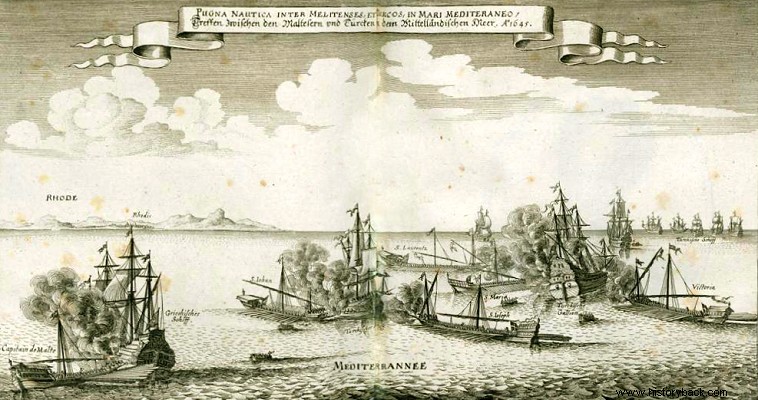
The Knights of St. John were a constant mortal threat to the Turks for centuries. The Knights never possessed strong numerical forces on land or sea, but their numerical inferiority was more than compensated by their qualitative superiority. At sea, in fact, the Knights usually did not care about the number or strength of the Turkish ships and rushed against them as soon as they spotted them...
Something like this also happened on September 28, 1644 when six galleons of the Knights, under Admiral "Chevalier" Boisbaudran spotted a Turkish convoy of 10 ships at a distance of 70 nm. from Rhodes. Besides the flagship, the ships of the Knights were the following:"St. Lavrentios", "Santa Maria", "Vitoria", "St. Joseph" and "St. John".
Among the Turkish ships there were also large sailing ships with many guns. The Turkish ships had sailed from the City in the direction of Alexandria. In one of them important persons of the Ottoman court were traveling on pilgrimage to Mecca. It is probable that one of the women of the sultan's harem was among the passengers , although the versions differ.
Boisbaudran immediately pursued with his flagship a ship which he believed to be Turkish. The boat, however, was Greek and Boisbaudran immediately tacked back and hurried to join his other boats. At the same time the "St. Laurentios, Santa Maria and Vitoria had attacked a large Turkish galleon and the "St. Joseph" and "St. John" a smaller sailing vessel.
Boisbaudran also attacked the large galleon. Epic conflict ensued with every kind of deadly and unwieldy weapon. The Knights managed to board the much taller, heavier and stronger Turkish vessel. Then the gates of hell opened. With swords in hand, the Knights charged against the Turks who were furiously defending. Boisbaudran was killed fighting like a true hero. Finally, after 7 whole hours of bloodshed and after at least 220 Turks out of more than 600 of the ship's crew were slaughtered, the rest surrendered.
The Knights, whose leadership was assumed by the master of "St. Laurentios" Raphael Cottoner , towed the heavy Turkish vessel and the other smaller galleon which was also captured. The other Turkish ships withdrew with damage and losses.
As for their own losses, the Knights had 82 dead and 170 wounded, against multiples of the Turks. The victors headed for Crete where they left behind prisoners and part of their booty. This event was also the reason for the outbreak of the Cretan War , as the Turks considered the Venetians "complicit" in the attack. Ultimately the great Turkish galleon did not reach Malta. It was abandoned in the middle of the ocean and crashed on the rocks of the coast of Calabria.
